CATHEDRAL QUEST
Our quest to experience the great cathedrals and churches of Europe
Amsterdam and Poland 2017
Day 14, Sat, June 17
Gdansk
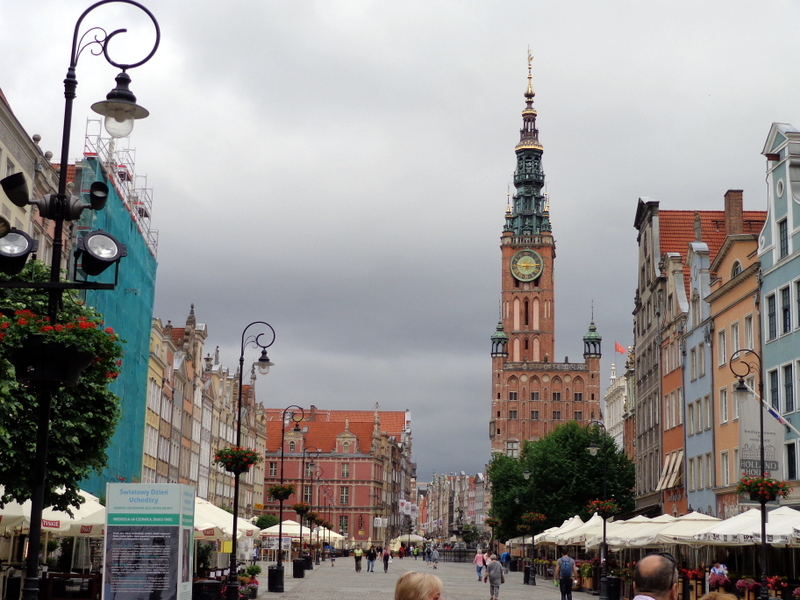 We
had a good breakfast in our hotel and gathered with the group and a
local tour guide for a walking tour of the old town, Gdansk. We
passed a lot of interesting and lovely buildings, which I shall try to
describe in some detail.
We
had a good breakfast in our hotel and gathered with the group and a
local tour guide for a walking tour of the old town, Gdansk. We
passed a lot of interesting and lovely buildings, which I shall try to
describe in some detail.
About 80% of Gdansk was destroyed during World War II. Gdansk, as
well as all Poland has had a very interesting and sad history with wars
with the Soviets, Prussians, the Nazis, and Austrians. At one time
Poland didn't even exist. After WWII, Communism took over until
1989. Gdansk has been beautifully restored.
Brama Zielona
(
The Green Gate)
The Renaissance Green gate stands on the site
of the
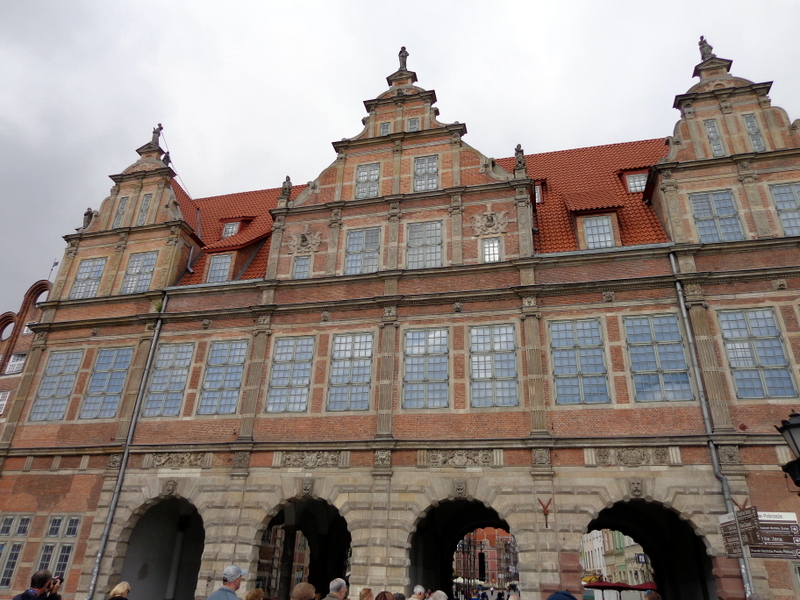 most
ancient gate in Gdansk, the Koga Gate. This gate served as the formal
residence of the Polish monarchs, but was only used once for that
purpose in its history. There are four arched passages through this gate
and there is a symbol over each: the eagle of the Prussian Kings, and
the emblems of Poland, Gdansk, and Royal Prussia.
most
ancient gate in Gdansk, the Koga Gate. This gate served as the formal
residence of the Polish monarchs, but was only used once for that
purpose in its history. There are four arched passages through this gate
and there is a symbol over each: the eagle of the Prussian Kings, and
the emblems of Poland, Gdansk, and Royal Prussia.
The gate was designed in the Mannerist style by the architect
Johann Kramer from Gdansk, and built in 1564 – 1568. The former Polish
President and symbol of Solidarity, Lech Walesa had his office in the
Green Gate.
Dom Przyrodnikow
(The House of the Natural Science Society)
 One
of the first buildings that we stopped to admire was the House of the
Natural Science Society, which is adjacent to
Mary’s Gate. There were three
interesting little statues in front, but as I write this I can find no
reference to them on the Internet. This building is the first one on my
model of the Long Embarkment.
Click here to see model.
One
of the first buildings that we stopped to admire was the House of the
Natural Science Society, which is adjacent to
Mary’s Gate. There were three
interesting little statues in front, but as I write this I can find no
reference to them on the Internet. This building is the first one on my
model of the Long Embarkment.
Click here to see model.
Spichrze (The Granaries)
Across the river were the old Gdansk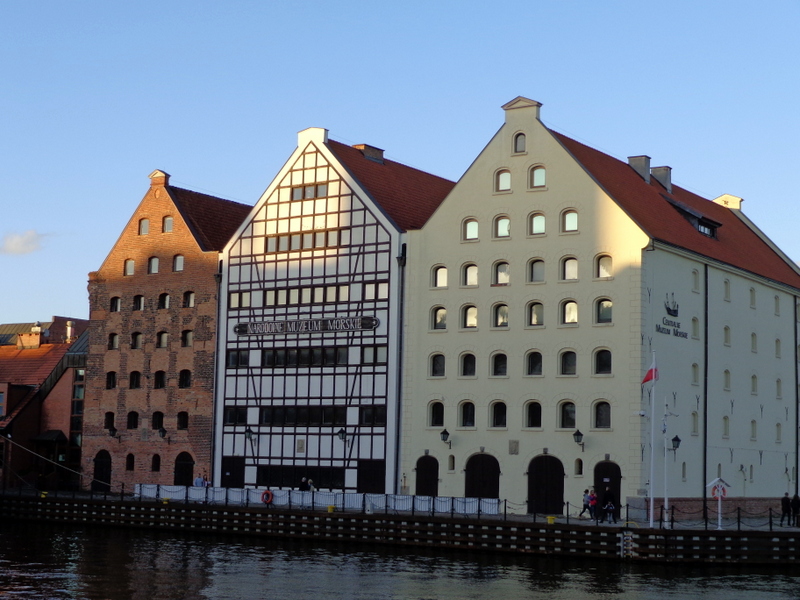 Granaries . The majority of granaries in Gdansk were destroyed as a
result of war in 1945. The walls on three of them were preserved and
after reconstruction in 1985 the
granaries became the main area for
Polish Marine use.
Granaries . The majority of granaries in Gdansk were destroyed as a
result of war in 1945. The walls on three of them were preserved and
after reconstruction in 1985 the
granaries became the main area for
Polish Marine use.
The
granary on the left (in the photo) is the oldest one which is Gothic and
named Olivean. Its name derived from the Cistercian Order from Oliwa.
The middle granary is name Copper which comes from the type of goods
once stored there. The granary on the far right is Baroque and named “
Panna” or “maiden” after a sculpture once standing on the top.
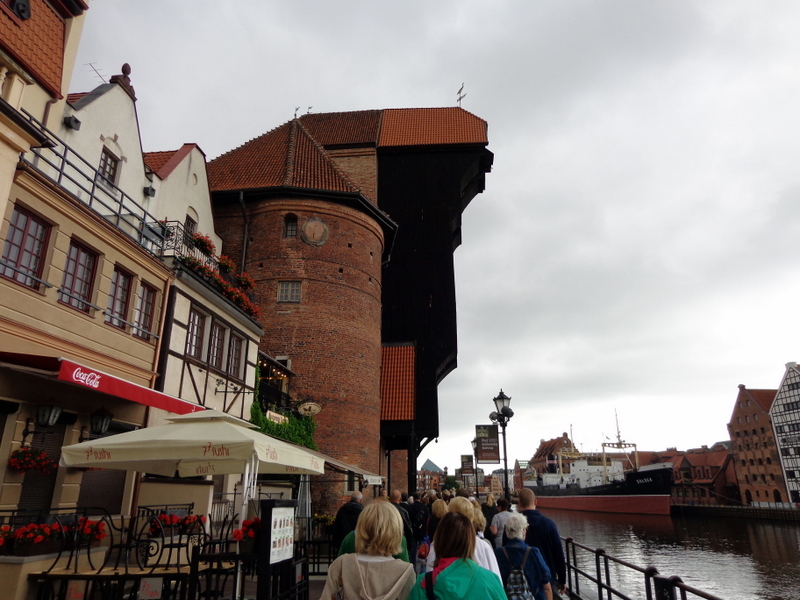 C
Crane
Gate
Our
next
The
large w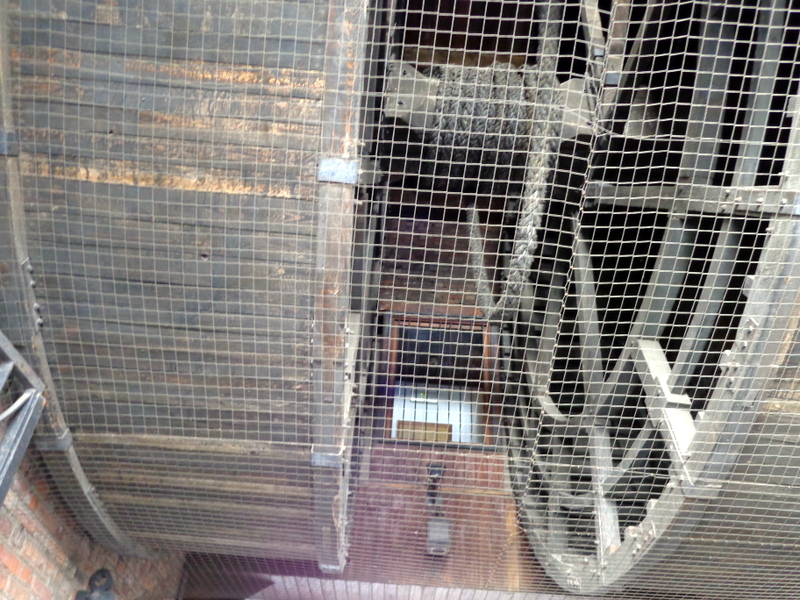 heels,
which were moved by men inside the wheel, like hamsters, raised and
lowered the crane. We
walked through the Crane Gate and saw streets where the front porches
survived and new buildings were built behind them.
heels,
which were moved by men inside the wheel, like hamsters, raised and
lowered the crane. We
walked through the Crane Gate and saw streets where the front porches
survived and new buildings were built behind them.
BAZYLIKA MARIACKA (St.
Mary’s Cathedral)
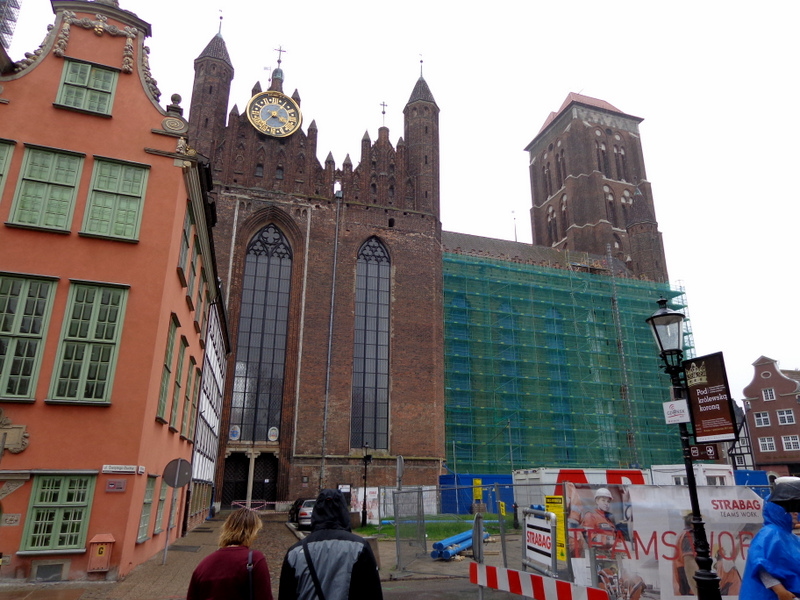 Our
next stop was
St. Mary's Cathedral, which is the largest BRICK cathedral in the world.
This huge Gothic church was started in the 14th century. At the
turn of the 14th and 15th centuries the church was rebuilt and greatly
enlarged. The final shape of the church was achieved over 150 years
after initial building work had begun. At this time the side aisles and
the stellar vaulted ceiling, the most beautif
Our
next stop was
St. Mary's Cathedral, which is the largest BRICK cathedral in the world.
This huge Gothic church was started in the 14th century. At the
turn of the 14th and 15th centuries the church was rebuilt and greatly
enlarged. The final shape of the church was achieved over 150 years
after initial building work had begun. At this time the side aisles and
the stellar vaulted ceiling, the most beautif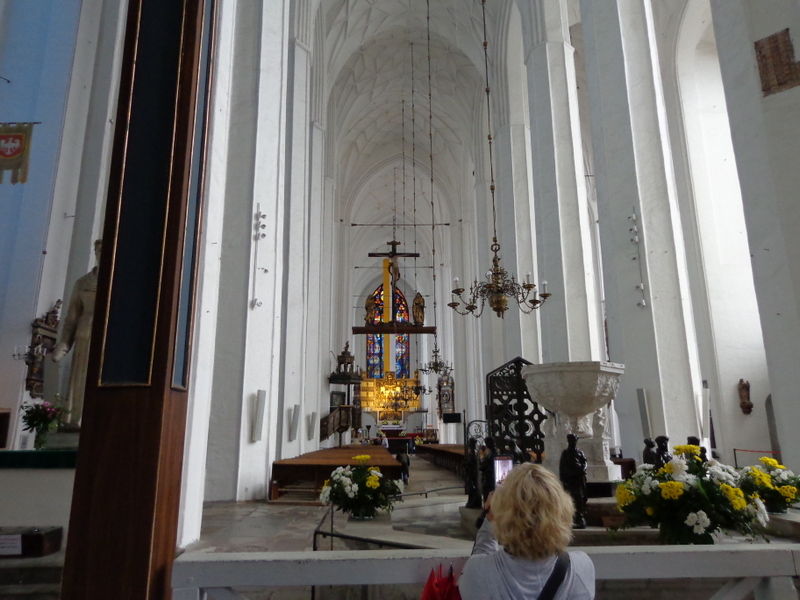 ul
in Poland, was added. The dimensions are very impressive – the nave is
344 ft long and 216 ft wide. St. Mary's Church is a triple-aisled hall
church with
a triple-aisled transept.
Both the transept and the main nave are
of similar width and height.
ul
in Poland, was added. The dimensions are very impressive – the nave is
344 ft long and 216 ft wide. St. Mary's Church is a triple-aisled hall
church with
a triple-aisled transept.
Both the transept and the main nave are
of similar width and height.
It
has been Catholic, then Lutheran and now Catholic again. The
inside was rather plain. The wall had been painted with fresco at
one time,t had been painted over
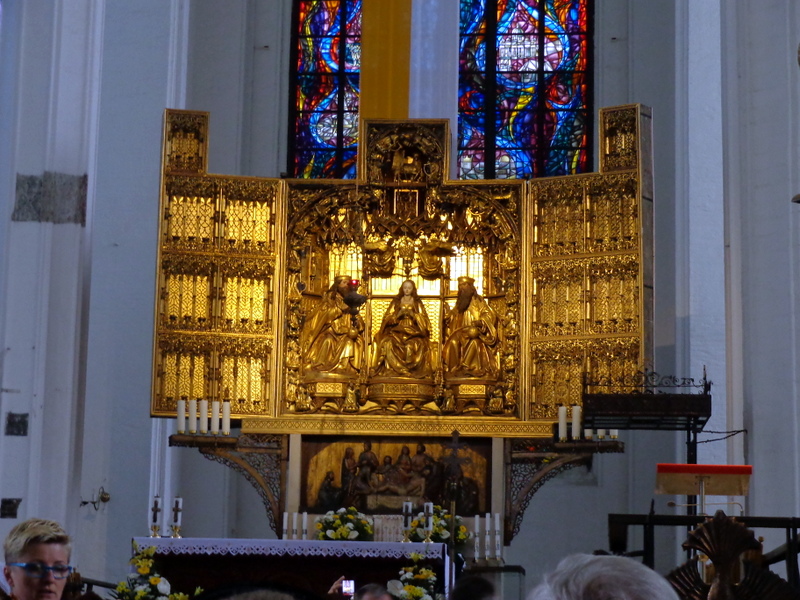 decorated
with several
master pieces
of Gothic, Renaissance and
Baroque painting.
The high altar has a Gothic gold triptych, which was
a popular format
for altar paintings from the Middle Ages onwards.
A triptych consists of a central panel and two hinged "wings". St.
Mary’s triptych is from the 1510s,
with the Coronation of the Virgin depicted in its central panel.
decorated
with several
master pieces
of Gothic, Renaissance and
Baroque painting.
The high altar has a Gothic gold triptych, which was
a popular format
for altar paintings from the Middle Ages onwards.
A triptych consists of a central panel and two hinged "wings". St.
Mary’s triptych is from the 1510s,
with the Coronation of the Virgin depicted in its central panel. 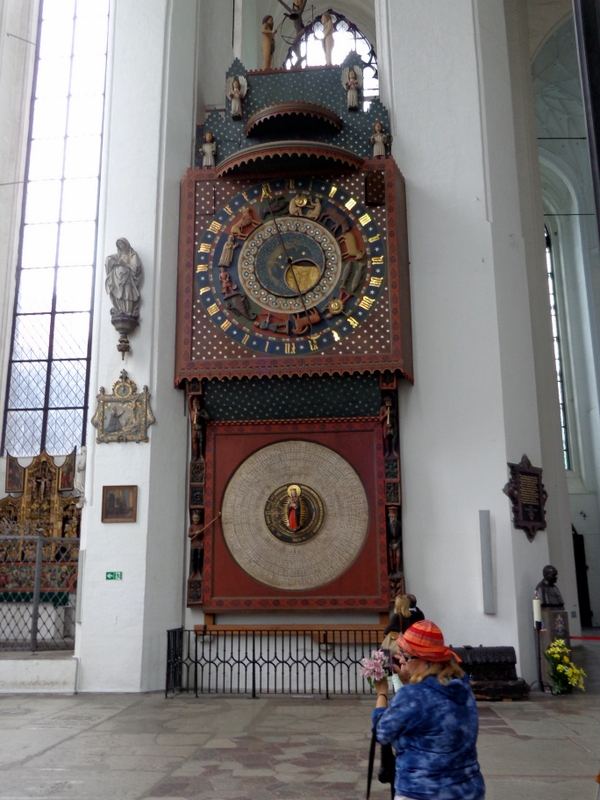
St. Mary's contains many relics from the
past, including a wooden pieta and a 500 year old astronomical clock.
The major reconstruction was needed after
the Second World War, but all of its valuable fittings were saved.
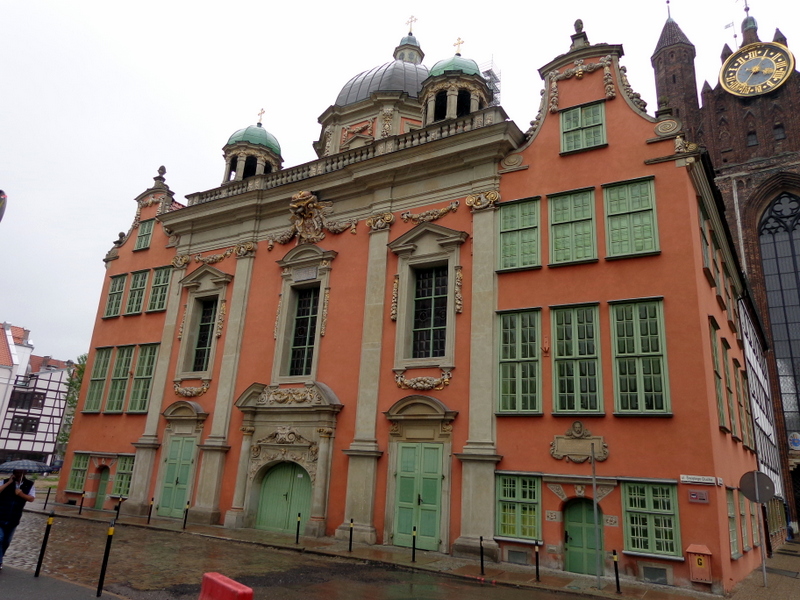 The
Royal Chapel of St. Mary's Church, adjacent to the Cathedral, was built
by King Jan III Sobieski in Baroque style. Its sherbert-colored face
with ivory columns stands out in contrast to the dark brick of the
church itself.
The
Royal Chapel of St. Mary's Church, adjacent to the Cathedral, was built
by King Jan III Sobieski in Baroque style. Its sherbert-colored face
with ivory columns stands out in contrast to the dark brick of the
church itself.
Wielka Zbrojownia
(The
Great Armoury)
The Great Armoury was built in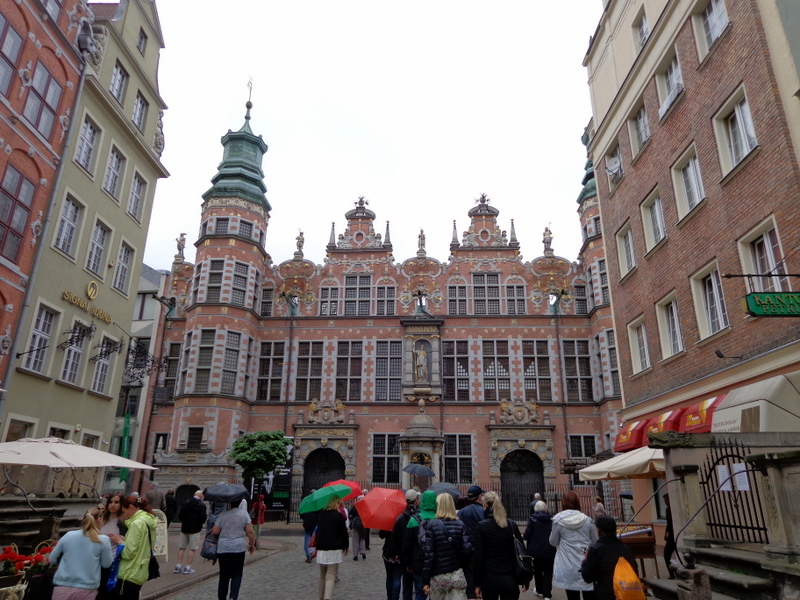 1600-09 on the medieval line of the city
walls. A working arsenal until the 1800's, the armoury remains the
finest example of Renaissance architecture in the city. It was designed
by Opberghen and is the most impressive of his works in Gdańsk.
1600-09 on the medieval line of the city
walls. A working arsenal until the 1800's, the armoury remains the
finest example of Renaissance architecture in the city. It was designed
by Opberghen and is the most impressive of his works in Gdańsk.
The well-like structure in front was used as an elevator to transport
gunpowder and cannon balls from their storage place in the basement. The
armoury was badly damaged in WWII and had to be completely rebuilt and
its only in recent years that it has regained its former glory following
a spell during which it even played host to a supermarket. It's now open
as an art gallery and there's a smart wine bar on the ground floor.
Neptune Fountain
 Further down the street we came to the Neptune fountain
on Long Market, a
few steps from the Artus Court. Neptune’s Fountain is a Mannerist
monument cast in bronze in the city in 1615 but wouldn’t be installed
for another 18 years.
Further down the street we came to the Neptune fountain
on Long Market, a
few steps from the Artus Court. Neptune’s Fountain is a Mannerist
monument cast in bronze in the city in 1615 but wouldn’t be installed
for another 18 years.
Located by the palatial townhouses where
Poland’s royalty would stay in Gdańsk, the fountain’s sculpture shows
Neptune bowing his head slightly as a sign of deference.
THE ARTUS COURT
This mansion, a symbol of the city's pow er in the 16th and 17th
centuries, served as an exchange and as the seat of St. George and the
brotherhoods of rich patricians. Founded as a meeting place for
merchants and dignitaries, it was named after King Arthur, of Round
Table fame, and hosted many a noble guest. Following a fire in 1841, it
was given a more Gothic form, complete with ostentatious sculptures and
paintings illustrating man's merits and vices. The court still plays an
important part in public life today and is the scene of many receptions
and meetings.
er in the 16th and 17th
centuries, served as an exchange and as the seat of St. George and the
brotherhoods of rich patricians. Founded as a meeting place for
merchants and dignitaries, it was named after King Arthur, of Round
Table fame, and hosted many a noble guest. Following a fire in 1841, it
was given a more Gothic form, complete with ostentatious sculptures and
paintings illustrating man's merits and vices. The court still plays an
important part in public life today and is the scene of many receptions
and meetings.
Our walk, which started with some rain and cool weather, took 2 hours.
The group then had an option to say in town on our own or go to Sopot
which is a nearby beach. We decided to stay in town and look
for the buildings, gates, and towers of the model kits I have for
Gdansk.
THE BRAMA KROWIA
(The Cow
Gate)
We
had a list of all of the models, and a map of their location.
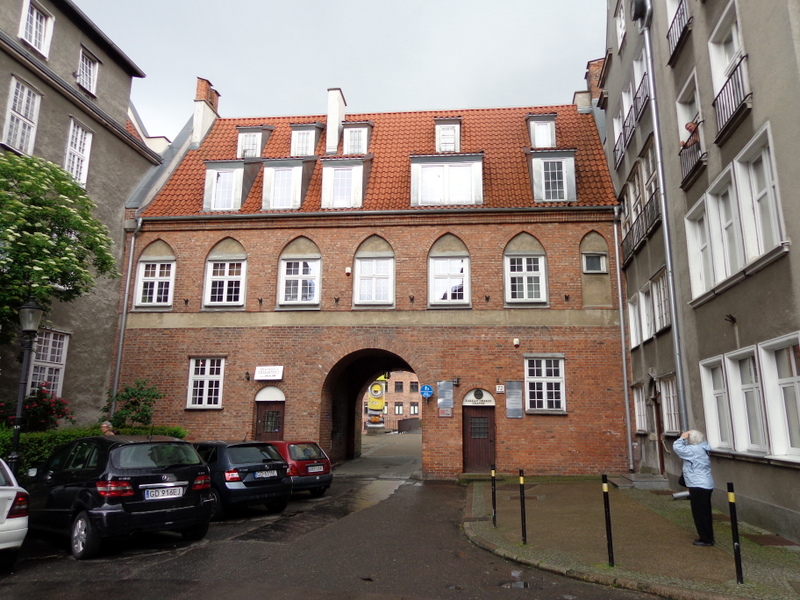 The Cow
Gate is found next to what was once the ‘Butter Market’. Thought to have
been built in the 14th century, the building was given a through
redesign five hundred years later. This, miraculously almost survived
the war, but not the town planners who arrived after. Clearly inspired
by the ruins around them they chose to knock this place down, and
rebuild it in something similar to its original form. This was a common
practice after WWII where the new Polish authorities decided to recreate
buildings from the end of the 18th century, before Gdańsk was
partitioned rather than rebuild what had stood there in 1939.
CLICK HERE TO SEE MY MODEL
The Cow
Gate is found next to what was once the ‘Butter Market’. Thought to have
been built in the 14th century, the building was given a through
redesign five hundred years later. This, miraculously almost survived
the war, but not the town planners who arrived after. Clearly inspired
by the ruins around them they chose to knock this place down, and
rebuild it in something similar to its original form. This was a common
practice after WWII where the new Polish authorities decided to recreate
buildings from the end of the 18th century, before Gdańsk was
partitioned rather than rebuild what had stood there in 1939.
CLICK HERE TO SEE MY MODEL
BASZTA KOTWIEZNIKOW (THE ANCHOR TOWER)
This tower was
erected on a square plan
 in 1361, for additional protection flanking the
then southern fortifications
of Gdańsk and
the former shipyard areas (in
today's Lastadia street).
in 1361, for additional protection flanking the
then southern fortifications
of Gdańsk and
the former shipyard areas (in
today's Lastadia street).
After moving the outer belt of Gdańsk fortifications, the tower lost its current military significance. In the years 1570-1575 Paulus van der Horne rebuilt the building to a city prison for particularly dangerous criminals.. From 1865, the tower served as the main police detention center of the Main Town .
During
the Second
World War, the tower
was almost completely destroyed; it lost its roof, all the internal
ceilings and the entire south-west corner . The building was reconstructed in
1968-1969.
In 1975, the
tower was transferred to the seat of the then Office for Research and
Documentation of Monuments of the
Gdańsk Province and
fulfilled its function as the seat of conservation services.
In 2014, the Anchor Tower was rented for purposes related to the activities of the organization that manages monthly magazines. NOTE THE SMALL DOOR ON THE LEFT SIDE - THE ONLY DOOR INTO THE BUILDING. PLEASE VISIT MY MODEL
Dwor Miejski (City
Stables)
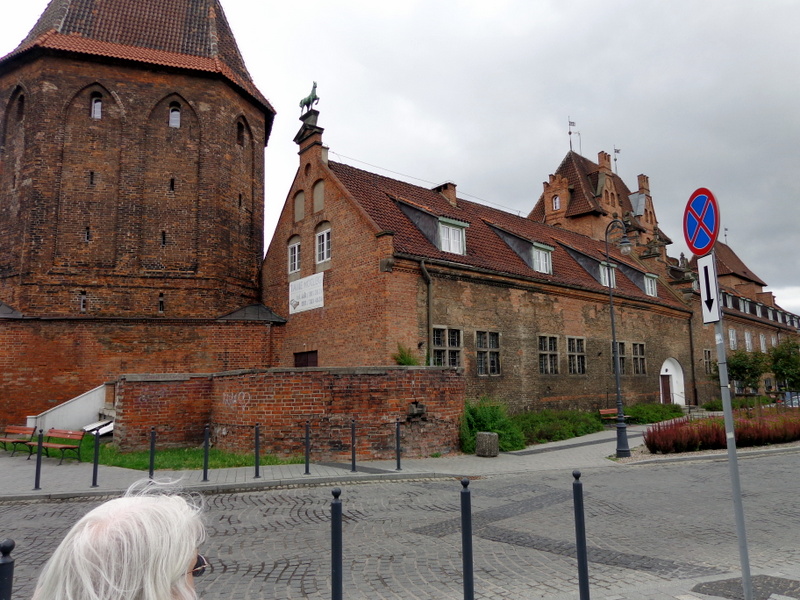
One of the models that I had already made before the trip was of
the old stables. It was a long building which now houses a hotel and
several businesses.
The
corner tower, defending the southwest contact of the city walls, began
to rise as early as in 1343, and in the 14th century the brewery was
founded. Both of these buildings had only three walls in their original
form, because they were open from the city. The tower bearing the
name Schultza (19th century Gdańsk painter, educator and lover of
monuments) was found in the last quarter of the 14th century.
The
attached buildings were called the Municipal Court, which housed, among
others, stables and city wagons.
From
1616 to 1619, the urban builder J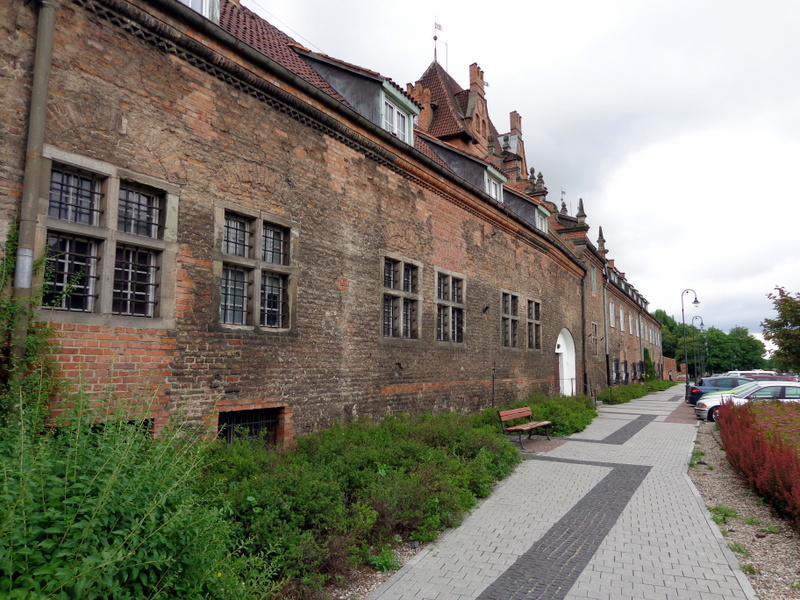 an Strakowski used medieval walls as
walls of newly built buildings and urban stables. They survived as a
complex until the Napoleonic Wars, during which the various objects have
undergone, unfortunate changes. At the beginning of the 20th century the
municipal court became the seat of the Municipal fire brigade.
an Strakowski used medieval walls as
walls of newly built buildings and urban stables. They survived as a
complex until the Napoleonic Wars, during which the various objects have
undergone, unfortunate changes. At the beginning of the 20th century the
municipal court became the seat of the Municipal fire brigade.
In
1945 the roofs and vaults of the former stables were collapsed, as well
as part of the brewery tower. The reconstruction of the entire complex
began in 1959 and was carried out in stages over a dozen years. After
reconstruction, all the objects were placed under the responsibility of
the Polish Scouting Association.
PLEASE
VISIT MY MODEL.
Golden Gate
W e had lunch outside, in an Italian cafe facing one of the
Golden Gate.
Kathleen had a pizza and I had gnocchi with shrimp, tomatoes and a few
other interesting things.
e had lunch outside, in an Italian cafe facing one of the
Golden Gate.
Kathleen had a pizza and I had gnocchi with shrimp, tomatoes and a few
other interesting things.
T he Golden Gate
designed by architect Abraham van den Block
was built in 1612-14, but has been reconstructed and
repainted many times throughout the years.
It is one of the most notable tourist attractions of the city. It is located at one end of Long Embankment and forms a part of the old city fortifications.
Jacek Tower
Built at the end of the fourteenth centu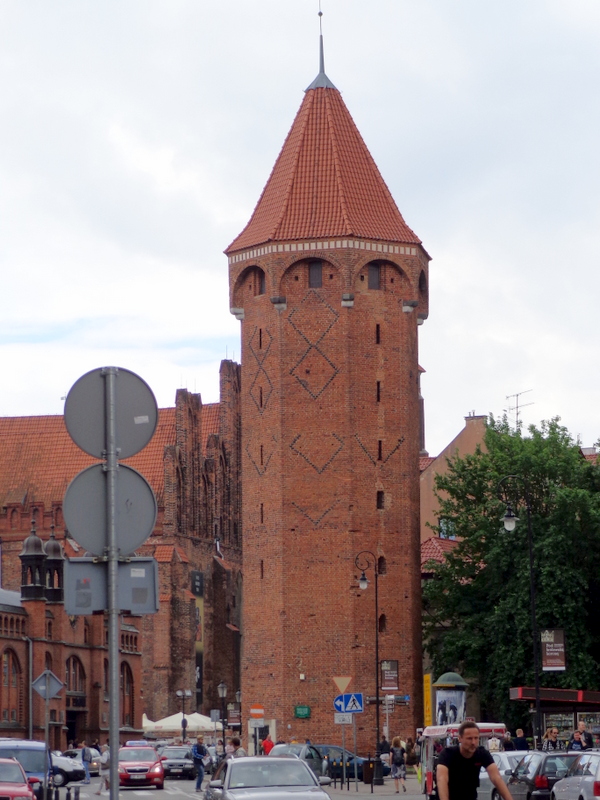 ry, the soaring tower owes its
name to Saint Jacek Odrowąż, who was the first Polish Dominican to
accept the invitation of
Duke
Świętopełk Wielki in 1227 and founded a monastery in Gdańsk together
with a group of brothers.
ry, the soaring tower owes its
name to Saint Jacek Odrowąż, who was the first Polish Dominican to
accept the invitation of
Duke
Świętopełk Wielki in 1227 and founded a monastery in Gdańsk together
with a group of brothers.
The tower, measuring 118
high, was the tallest building of this type in Gdańsk and best
prepared for defensive operations.
For a time, the tower was described as a playful name "Kiek in die
Koek" because from the top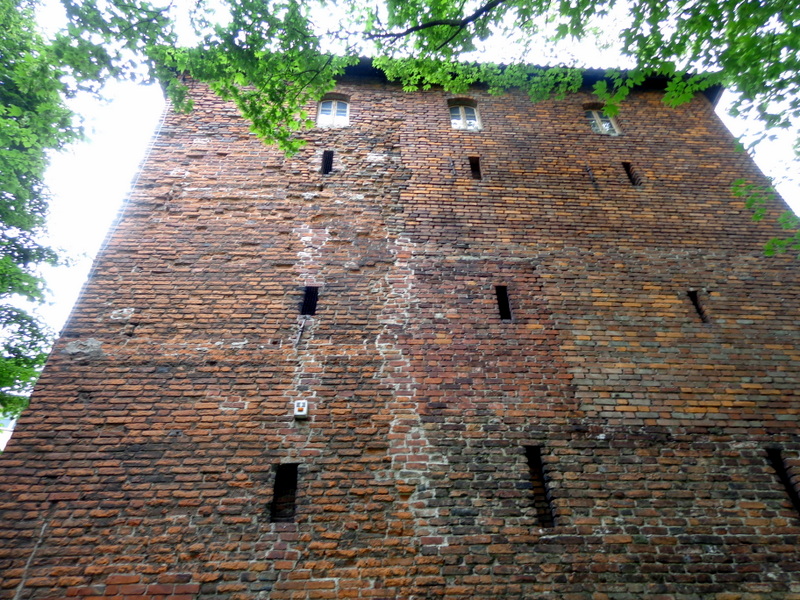 floors it was possible to observe the
kitchen preparation in a nearby monastery.
floors it was possible to observe the
kitchen preparation in a nearby monastery.
During the WWII, the roof was destroyed, some of the upper parts of
the building suffered as well. After the repair, the look of the tower
is in line with its configuration of 1556.
PLEASE SEE MY MODEL
Kosciol Sw.
Katarzyny
(St
Catherine's Ch urch)
urch)
St.
Catherine’s Church is the
oldest church in Gdańsk, dating back to the 14th century. Originally,
St. Catherine’s was a Protestant church in a city which has endured
Teutonic times, the Prussian empire, Hanseatic times, the Free City of
Danzig and the era o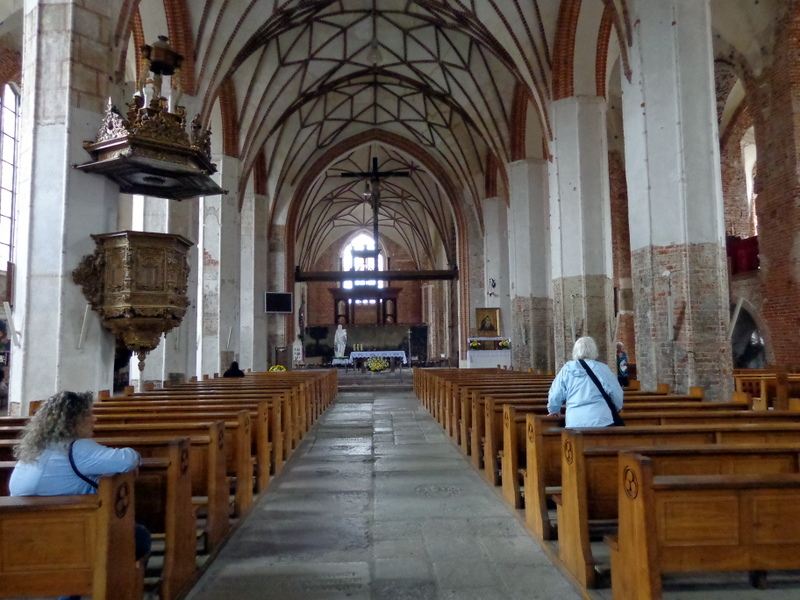 f communist rule. Since 1945 however, it has been
used solely as a Roman Catholic church. Of real significance, it has the
world’s first ever pulsar clock, which uses radio pulses from pulsars to
keep the time.
f communist rule. Since 1945 however, it has been
used solely as a Roman Catholic church. Of real significance, it has the
world’s first ever pulsar clock, which uses radio pulses from pulsars to
keep the time.
THE GREAT MILL
The Great Mill was built in the mid-14th century as one of the mos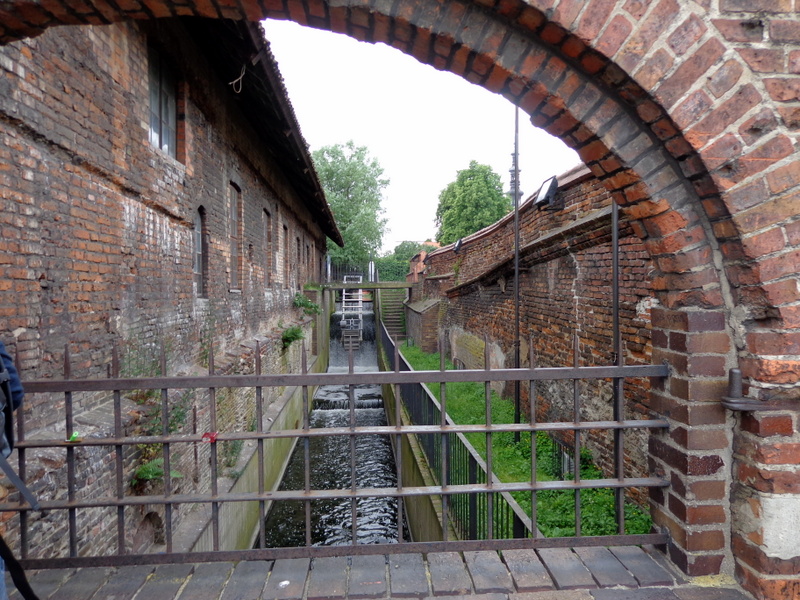 t
important Teutonic investments in Gdańsk. The mill was located between
the arms of the Raduni
Canal.
The mill was driven by 12 water circles (six on each side), and had a huge
attic equipped with a warehouse for grain and floated flour.
t
important Teutonic investments in Gdańsk. The mill was located between
the arms of the Raduni
Canal.
The mill was driven by 12 water circles (six on each side), and had a huge
attic equipped with a warehouse for grain and floated flour.
Malt barley was also processed in the mill in such quantities that local
needs were met and there were opportunities to export it also.
The Great Mill was also
regarded as a strategic object and, for example, the successful
anti-Teutoni c uprising of February 1454 began with the acquisition of
this building.
c uprising of February 1454 began with the acquisition of
this building.
At the beginning of the 17th century a huge bakery oven was
added, a little later the drive wheels of the facility was expanded to
the sides of the building. There were up to 18 bucket wheels used.
In the 19th century steam turbines were installed which replaced with electric motors. The mill functioned until the end of World War II.
Dower Mlynarzy (Manor of Millers)
 One
of the most beautiful half timbered buildings in Gdansk is The Manor of
Millers, which is located on the so-called islet – a spur which forms
the arms of the forking Radunia chanel. It was erected in 1831.
Due to its poor technical condition at the end of the 19th century it
was demolished, then newly erected on the initiative of history
enthusiasts. In 1945, it was destroyed. In 1997, thanks to the preserved
documentation, it was re-created.
One
of the most beautiful half timbered buildings in Gdansk is The Manor of
Millers, which is located on the so-called islet – a spur which forms
the arms of the forking Radunia chanel. It was erected in 1831.
Due to its poor technical condition at the end of the 19th century it
was demolished, then newly erected on the initiative of history
enthusiasts. In 1945, it was destroyed. In 1997, thanks to the preserved
documentation, it was re-created.
Kathleen found a park bench across the steet on which to rest while I walked further to see the Old Town Hall.
